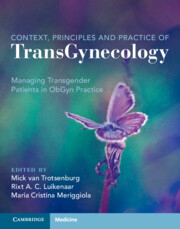Book contents
- Context, Principles, and Practice of Transgynecology
- Context, Principles, and Practice of Transgynecology
- Copyright page
- Dedication
- Contents
- Foreword
- Preface
- Contributors
- Abbreviations
- Section A Contextual Transgynecology
- Section B Practicing Transgynecology
- Chapter 9 Gynecological Office Medicine for Trans and Gender Diverse People
- Chapter 10 Features of Imaging in Transgender Persons
- Chapter 11 Benign Gynecological Conditions in Transgender and Gender Diverse People
- Chapter 12 Urogynecological Disorders
- Chapter 13 Painful and Frequent Micturition
- Chapter 14 Diagnostics and Treatment of Gynecological and Nongynecological Causes of Pelvic Pain
- Chapter 15 Gynecological Attention to the Prostate
- Chapter 16 Vaginal Dilators and Dilating after Vaginoplasty
- Chapter 17 Transenology
- Section C Gynecological Surgery for Transgender Males
- Section D Sexuality and Contraception
- Section E Fertility and Reproduction
- Section F Impact of Gender-affirming Hormonal Therapy on Genital Organs
- Section G Screening and Prophylaxis
- Transgynecology Index
- References
Chapter 9 - Gynecological Office Medicine for Trans and Gender Diverse People
from Section B - Practicing Transgynecology
Published online by Cambridge University Press: 22 December 2022
- Context, Principles, and Practice of Transgynecology
- Context, Principles, and Practice of Transgynecology
- Copyright page
- Dedication
- Contents
- Foreword
- Preface
- Contributors
- Abbreviations
- Section A Contextual Transgynecology
- Section B Practicing Transgynecology
- Chapter 9 Gynecological Office Medicine for Trans and Gender Diverse People
- Chapter 10 Features of Imaging in Transgender Persons
- Chapter 11 Benign Gynecological Conditions in Transgender and Gender Diverse People
- Chapter 12 Urogynecological Disorders
- Chapter 13 Painful and Frequent Micturition
- Chapter 14 Diagnostics and Treatment of Gynecological and Nongynecological Causes of Pelvic Pain
- Chapter 15 Gynecological Attention to the Prostate
- Chapter 16 Vaginal Dilators and Dilating after Vaginoplasty
- Chapter 17 Transenology
- Section C Gynecological Surgery for Transgender Males
- Section D Sexuality and Contraception
- Section E Fertility and Reproduction
- Section F Impact of Gender-affirming Hormonal Therapy on Genital Organs
- Section G Screening and Prophylaxis
- Transgynecology Index
- References
Summary
Transgynecology provides care to maintain genital health and to remedy complaints and disorders irrespective of the individual’s gender. In this sense, Ob/Gyn practices are open to either transgender females after having had genital gender-affirmative surgery (and sometimes already prior to surgery for counseling and preparatory work-up), and for transgender males prior and after surgical procedures and of course for gender diverse persons.
The challenge of running an Ob/Gyn practice open to trans and gender diverse people is to overcome prejudices and stereotypes on the side of the gynecologist and staff, the cisgender patients visiting this practice, and fears on the side of trans and gender diverse people. Fears for respectless behavior and fears to expose a physical region heavily burdened with emotions and sometimes also burdened with shame. the first visit especially determines whether a trustful and supportive relationship can be established.
In daily Ob/Gyn practice dealing with transgender people, it is also of importance to anticipate the effects of gender-related wording, as it may lead to irritation and can negatively affect the patient–physician relationship.
This chapter focuses on the gynecological needs and what gynecology essentially means to transgender people. What needs meet gynecology?
- Type
- Chapter
- Information
- Context, Principles and Practice of TransGynecologyManaging Transgender Patients in ObGyn Practice, pp. 67 - 71Publisher: Cambridge University PressPrint publication year: 2022



